
Affilation:
Chair Visual Communication, University of Wuppertal, Faculty of Art & Design; Director of the German Colour Association; Chief Editor of Colour.education
Paper title:
Assessment of the psychological and medical effects of the environmental factors colour and light on patients and staff in the department of intensive-care medicine
Brief paper description:
Project partners: HELIOS University Hospital Wuppertal – clinic of intensive-care medicine, Prof. Dr. Axel Buether, Visual Communication, University of Wuppertal Faculty of Design & Art / Dr. Gabriele Wöbker Head physician of the clinic in intensive-care medicine. Research questions: (1) Which impact has the design of colour and light in intensive care units on the well-being and health status of the patients? (2) Which impact has the design of colour and light in intensive care units on the motivation to work, the demeanour, and the well-being of the medical as well as the nursing staff? (3) Which impact has the design of colour and light in intensive care units on the consumption of medication? Summary of the Results: Significant improvements in the quality of stay and experience of patients and staff were observed and proven in all areas covered. The ill health status amongst ward personnel fell by 23,12 % within one year compared to both previous years. The severe skill shortage enhances this result with additional relevance. The consumption of medication could be reduced distinctly. At the benzodiazepines, no significant changes were observed. At the acute-neuroleptics (haloperidol, risperidone, chlorprothixene etc.), perspicuous changes occurred. In the reference period, the consumption decreased by averagely 30,1%. Particularly significant with the surveys of the patients was: • The medical and nursing staff were perceived distinctly calmer by the patients during their care (improvement by 35,7%); • The intensive care unit appeared distinctly nicer (improvement by 56,8%), more stimulating (improvement by 51,4%), more inviting (improvement by 50,0%), and warmer (improvement by 34,6%); • The atmosphere in the room took a significantly quieter effect to the patients (reduction of the noise level by 48,6%) and less hectic (improvement of the quiescent level by 40,6%). Particularly significant with the surveys of the staff was: • The staff satisfaction with the employer (improvement by 35,7%) and with their work (improvement by 35,1%) increased significantly; • The well-being was shown by the satisfaction with the condition of the workplace (improvement by 51,2%), the break room (improvement by 66,7%), the patient rooms (improvement by 48,8%) as well as the corridors and other work areas (improvement by 45,2%); • The colour design had a particularly strong impact on the assessment of orientation (improvement by 42,9%), colourfulness (improvement by 58,7%), artificial light quality (improvement by 52,4%), daylight quality (improvement by 48,7%), and identity (improvement by 50,0%).
Website Organizer: THE INTERNATIONAL CONFERENCE OF THE COLOR SOCIETY OF RUSSIA


